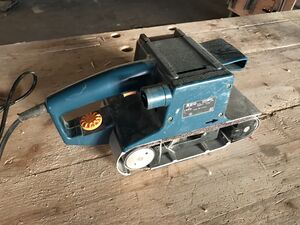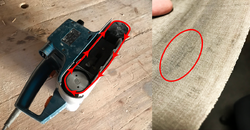Belt Sander
| MachineInfoBox AEG HBSE100 | |
|---|---|

| |
| Synonyms: | DE: Bandschleifer, Bandschleifgerät, Handbandschleifmaschine |
| Material: | wood, metals |
| Used with: | 560 × 100 mm sanding belts |
| Access Requirements: | Handheld Sander Introduction |
| Manual: | libble.eu |
| Tutors: | Lukas NitramLegov Pakue Lmnl99 Johannes Luzian Keno Sebastian Jakob |
| Similar (More or Less): | eccentric sander |
[[Has caption::handheld sander| ]]
This tool is not ready for use yet since not all commissioning steps have been completed. The process is also tracked on GitHub. Feel free to contribute to making it usable, any help is very welcome!
| Task | comment | Status |
|---|---|---|
| Name the tool: | AEG HBSE100 | done |
| Take a picture | - | done |
| Find the manual as PDF | libble.eu | done |
| Documentation | TODO: explain/illustrate belt direction | done |
| Print QR-Code | just outdated or trashed with the old machine? | pending |
| Introduction | Handheld Sander Introduction | done |
| Security Check | Cable has been replaced. Sander is quite loud; the bearings may be near the end of their life. | done |
| Test | to be done or witnessed by a manager | done |
| tool's name, owner and approx. value | provide to Patrick for inventorization | pending |
| Last step: make it available | physically and in the wiki - then delete this template | pending |
This tool will be a great addition for woodworking as well as other projects as it can also be used to grind metals. There are even advantages over stone-based grinders such as the larger surface and no chance of exploding stones. Belts may rip and go flying though, especially if they are installed in the wrong direction.
With the AEG HBSE100 it is strongly advised to wear hearing protection as it is quite loud!
Belts
This sander requires 560 × 100 mm belts. We might only have smaller belts at the moment, so be prepared bring your own!
If the belt often slips under pressure, it may have become stiff - this may be fixed by "massaging" it a bit in tight bends or replacing it with a new one.
The belt of a belt sander is directional. Make sure to install it in the correct direction (see illustration) otherwise it will get damaged quickly.
Stand

The Spanish Maker Román Palma shared instructions for a nifty three-position stand in Make: magazine, see the article and video here!
With such a stand we could use the belt sander as a simple substitute for a planer (DE: Hobelmaschine) or bench grinder.
